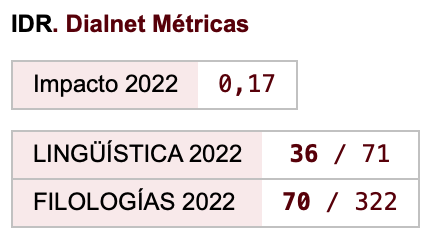Conceptualizing emotional distress in Late Middle English medical texts
Keywords:
Middle English, English for Specific Purposes, MEMT medical texts, metaphorsAbstract
In this paper I propose an analysis of the Middle English vocabulary for emotional distress. I am especially interested in determining to what extent the vocabulary used in medical varieties of Middle English differentiated between somatic and psychological distress and, eventually, between different types of adverse mood states. My research is based on the analysis of the data extracted from the Middle English Medical Texts, which includes a wide selection of medical treatises from c. 1375 to c. 1500. Special attention is paid to the metaphorical expressions of emotional distress in Middle English specialized texts.
Downloads
References
Early English corpora and dictionaries
HTOED. Historical thesaurus of the Oxford English dictionary (2009) Kay, Ch., Roberts, J., Samuels, M. and Wotherspoon, I. Oxford: OUP.
MEMT. Middle English Medical Texts (2005) Taavitsainen, I., Pahta, P. and Mäkinen, M. (compilers) CD-ROM. Amsterdam and Philadelphia: John Benjamins.
MED. Middle English dictionary, The (2001) Online edition. McSparran, Frances (ed.). Available <http://ets.umdl.umich.edu/m/med/>.
OED. Oxford English dictionary, The (2000–) Second edition, online version. Simpson, John (ed.). Available <http://www.oed.com>.
Secondary References
Crozier, R. & Alden, L. E. (2005). Essentials of social anxiety. London: Willey.
Daly, R. W. (2007). Before depression: The medieval vice of acedia. Psychiatry, 70(1), 30-51.
Díaz-Vera, J. E. (2009). Analysing the diffusion of scientific metaphors through a Corpus of Middle English medical texts. In J. E. Díaz-Vera & R. Caballero (Eds.), Textual healing: Studies in Middle English medical, scientific and technical texts (pp. 77-95). Rodopi: Amsterdam.
Elredge, L. M. (1991). A Thirteenth-century ophthalmologist, Benvenutus Grassus: His treatise and its survival. Journal of the Royal Society of Medicine, 91, 47-52.
Fesmire, S. A. (1994). Aerating the mind: The metaphor of mental functioning as bodily functioning. Metaphor and Symbolic Activity, 9, 31-44.
Geeraerts, D. & Gevaert, C. (2008). Hearts and (angry) minds in Old English. In F. Sharifian, R. Dirven & N. Yu (Eds.), Culture, body, and language: Conceptualizations of internal body organs across cultures and languages (pp. 319-347). Berlin: Mouton.
Gibbs, R. W. (1994). The poetics of mind: Figurative thought, language, and understanding. Cambridge: Cambridge University Press.
Harbus, A. (2004). Thinking in metaphors: Figurative language and ideas on the mind. Sydney Studies in English, 30, 3-20.
Jackson, S. (1986). Melancholia and depression: From Hippocratic times to modern times. New Haven, CT: Yale University Press.
Kleinman, A. (1982). Neurasthenia and depression: A study of somatization and culture. Culture and Medical Psychiatry, 6, 117.
Kövecses, Z. (1986). A figure of thought. Metaphor and Symbolic Activity, 6, 29-46. Kövecses, Z. (1988). The language of love: The semantics of passion in conversational
English. Lewisburg: Bucknell UP.
Kövecses, Z. (1990). Emotion concepts. New York: Springer-Verlag.
Kövecses, Z. (2000). Metaphor and emotion. Cambridge: Cambridge University Press.
Lakoff, G. (1987). Women, fire, and dangerous things: What categories reveal about the mind. Chicago: The University of Chicago Press.
Lakoff, G. & Johnson, M. (1980). Metaphors we live by. Chicago: University of Chicago Press.
Lakoff, G. & Kövecses, Z. (1987). The cognitive model of anger inherent in American English. In D. Holland & N. Quinn (Eds.), Cultural models in language and thought (pp. 195-221). Cambridge: Cambridge University Press.
Lee, S. (1998). Estranged bodies, simulated harmony, and misplaced cultures: Neurasthenia in contemporary Chinese society. Psychosomatic Medicine, 60, 448-457.
Leff, J. P. (1988). Psychiatry around the globe. London: Gaskell.
Mize, B. (2006). The representation of the mind as an enclosure in Old English
poetry. Anglo-Saxon England, 35, 57-90.
Ots, T. (1990). The angry liver, the anxious heart, and the melancholy spleen: The phenomenology of perceptions in Chinese culture. Culture, Medicine, and Psychiatry, 14, 21-58.
Pritzker, S. E. (2003). The role of metaphor in culture, consciousness, and medicine: A preliminary inquiry into the metaphors of depression in Chinese and Western medical and common languages. Clinical Acupuncture & Oriental Medicine, 4(1), 11-28.
Voigts, L. E. (1982). Editing Middle English medical texts: Needs and issues. In T. Levere (Ed.), Editing texts in the history of science and medicine (pp. 39-68). New York: Garland.
Voigts, L. E. (1984). Medical prose. In A. Edwards (Ed.), Middle English medical prose: A critical guide to major authors and genres (pp. 315-335). New Jersey: Rutgers University Press.
Yu, N. (1998). The contemporary theory of metaphor: A perspective from Chinese. Amsterdam: John Benjamins Publishing Company.
Downloads
Published
How to Cite
Issue
Section
License
Authors who publish with this journal agree to the following terms:
- Authors retain copyright and grant the journal right of first publication with the work simultaneously licensed under a Creative Commons Attribution License that allows others to share the work with an acknowledgement of the work's authorship and initial publication in this journal.
- Authors are able to enter into separate, additional contractual arrangements for the non-exclusive distribution of the journal's published version of the work (e.g., post it to an institutional repository or publish it in a book), with an acknowledgement of its initial publication in this journal.
- Authors are permitted and encouraged to post their work online (e.g., in institutional repositories or on their website) prior to and during the submission process, as it can lead to productive exchanges, as well as earlier and greater citation of published work (See The Effect of Open Access).

Revista de Lenguas para fines específicos is licensed under a Creative Commons Reconocimiento-NoComercial-SinObraDerivada 4.0 Internacional License.























